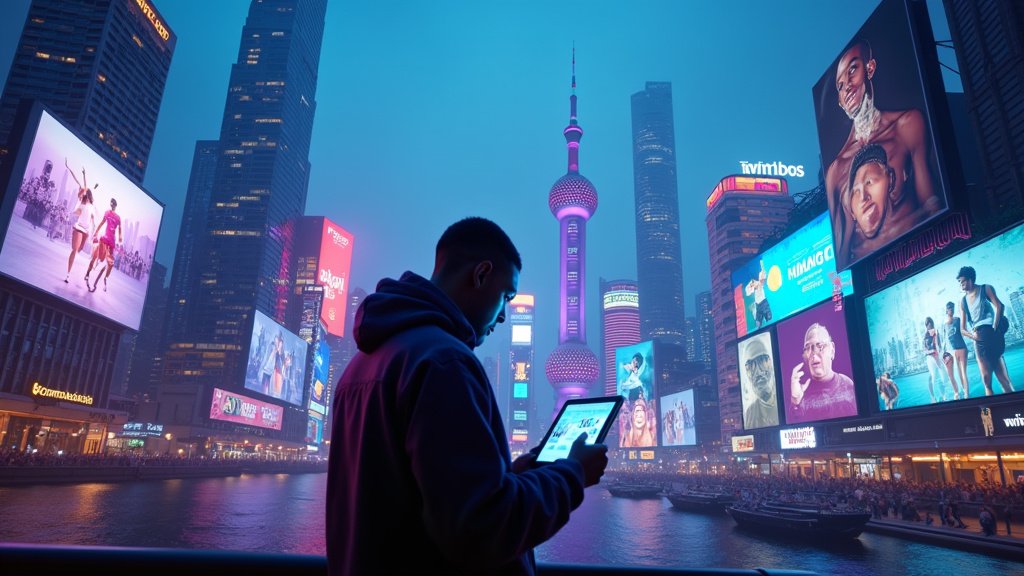Shanghai, China – At the forefront of a digital revolution, Chinese online content creators are no longer just reaching across borders; they are actively cultivating lasting global communities and shaping international trends. A comprehensive white paper, unveiled at the 2025 Shanghai Internet Audio and Video Content Creators Conference, details this significant expansion, highlighting a shift towards building sustainable cultural assets and leveraging technology to amplify reach.
The Global Ascendancy of Chinese Content
The report underscores a transformative phase where Chinese video creators are moving beyond mere export to establishing robust international followings. Food and culture vlogger Dianxi Xiaoge exemplifies this success, having amassed over 12 million subscribers on YouTube, drawing a global audience with his authentic portrayal of rural Chinese life. Similarly, the video-sharing platform Bilibili is making substantial inroads internationally, securing a spot among the top five video applications in Southeast Asia and ranking eighth in the United Kingdom.
Platforms as Global Bridges
Key Chinese platforms are instrumental in this global push. The lifestyle app RedNote, known internationally as Xiaohongshu, has witnessed a remarkable surge in its US daily active users, reaching 1.2 million. This growth is further validated by the presence of prominent international figures, including French football sensation Kylian Mbappé and NBA star Ja Morant, who are actively engaging with the platform. Often described as a blend of Instagram and Pinterest, Xiaohongshu has become a crucial hub for sharing lifestyle content and product reviews, particularly resonating with young female demographics and boasting significant advertising value. Bilibili, while historically known for its anime, comics, and games (ACG) content, has diversified to become a broader hub for pop culture and entertainment, attracting a massive user base, primarily under 35, who are keen on exploring varied content.
The Evolving Content Landscape: Culture, Style, and AI
This global expansion is fueled by a strategic emphasis on developing long-term cultural assets and sustainable income streams. Creators are adapting their formats to appeal to diverse audiences, moving beyond ephemeral viral hits towards content with lasting cultural resonance. The rise of generative artificial intelligence (AI) is a critical catalyst in this evolution. AI is significantly lowering entry barriers for aspiring creators and is projected to account for up to 90 percent of global online content by 2026. AI tools offer capabilities such as automated content generation, personalized content delivery, and multilingual translation, which are invaluable for cross-border reach and engagement. China is actively fostering its own AI ecosystem, with domestic generative AI products rapidly expanding onto the global stage and driving innovation in media creation. The prevalent trending content often reflects diverse aspects of Chinese culture and evolving global style.
A Booming Domestic Industry Fueling Global Ambitions
The domestic online audio-visual sector provides a strong foundation for this international outreach, having reached an impressive 1.22 trillion yuan (approximately US$168 billion) by the end of 2024. This robust market supports a vast ecosystem of over 1.62 billion creator accounts across short-video platforms. Recognizing the burgeoning potential, cities like Shanghai are actively implementing supportive policies. The city’s “Nine Measures” initiative aims to bolster high-quality internet content creation by providing financial support, streamlining visa processes for overseas talent, and encouraging creators to promote Shanghai’s international image and Chinese cultural intellectual property globally.
Conclusion
The concerted efforts by creators, platforms, and supportive government policies are propelling Chinese online content into a new era of global influence. From niche cultural vlogs to dynamic lifestyle sharing and AI-driven innovation, the reach and impact of China’s digital storytellers are expanding. As this trend continues, these creators are poised to become increasingly significant voices in the global digital news and cultural landscape.





